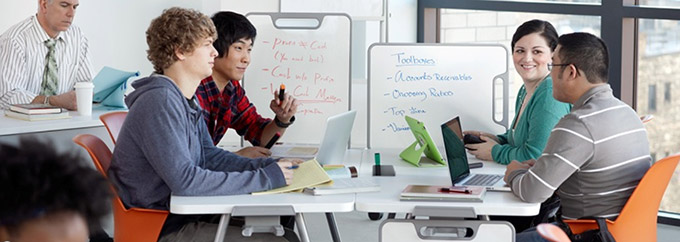 By Marisa Sergnese, training and professional development leader at Steelcase Education
By Marisa Sergnese, training and professional development leader at Steelcase Education
Steelcase Education believes that pedagogy, technology and space are three key elements of an active learning environment. Just as we all grapple with the ongoing rapid-fire upgrades and updates to our digital devices, new technologies in education also continue to emerge. Consequently, teaching methods evolve and classroom spaces are reconfigured to support student learning and sustain the diversity of content, interaction and inquiry. The blended learning model of instruction provides a welcome combination of online delivery of curriculum content with face-to-face instruction. This approach accommodates a variety of learning styles that impacts the quality of education for students. Accordingly, educators are finding they have more time for focused discussions permitting students to delve deeper into topics of interest they wish to further explore.
The blended learning model represents a significant shift from the traditional classroom approach. The primary difference is the shift from teacher-led classrooms to more student-centered instruction. Anytime a student engages in the traditional supervised brick-and-mortar schooling experience combined with the benefits of online activities, whether self-directed, self-paced, or collaborative, they are applying the blended learning methodology. This combination of traditional classroom instruction and online activities provides far more personalized, productive, and engaging learning experiences for students. Students are empowered to work at a pace they set and encouraged to become more responsible for their learning. Educators are better able to engage with students and coach them towards a more individualized experience to experience greater success. Increasing learner control and responsibility appears to result in heightening student engagement. This is an important point that we all believe leads to better learning outcomes.
More and more, we are learning that technology is impacting the student by giving them greater opportunities for intervention, reflection and evaluation throughout their learning process. In a traditional classroom, the opportunity for feedback from instructors and other students may be limited within the classroom environment and assigned time period. In a blended learning environment, there can be continuous, ongoing feedback from multiple sources, at different points in time, that can help an instructor assist the learner to assess their understanding and adjust their learning accordingly. Such authentic assessment techniques are afforded to us as a result of a variety of technology tools that support more immediate feedback.
At Steelcase Education, we have researched both formal and informal learning environments. It is important to note that our informal learning framework speaks to what we already know about how students choose to work. Understanding what we already know and looking at what this means within a blended learning environment will take time. What we do know is that as learning becomes more self-directed and self-paced, there are greater student and instructor choices, providing a more dynamic and meaningful learning experience. The rise of blended learning programs affects both formal and informal learning spaces. Neither of these two types of learning environments exists in isolation of the other. In an emerging blended learning model, these types of learning environments co-exist and complement one another to support a more active, connected and focused rhythm of learning.
Many instructors are attempting to implement blended learning strategies. The greatest barrier they face is the lack of professional learning opportunities to understand the goals and objectives of a blended learning initiative. A better understanding of what blended learning offers and looks like can help instructors better prepare their spaces, content and interactions. While there is always pushback when something new is implemented, instructors require dedicated time to develop a clear understanding of why and how blended learning is important to the students learning process and skill mastery. Current learning environments, whether formal or informal, may not provide the balance and array of opportunities for more individualized and personalized learning. At Steelcase Education, we continue to observe both instructor and teacher behaviors to affirm our insights and keep current with the trends and factors that influence daily performance. As schools are being asked to do more with less, the blended learning approach offers an innovative structure to address the needs of our 21st century learners.
Marissa Sergnese is the training and professional development leader at Steelcase Education and will be on hand at the Steelcase Education booth at ISTE, booth #1140


Pingback: EdTech: What is Blended Learning? [ISTE] | Tech...